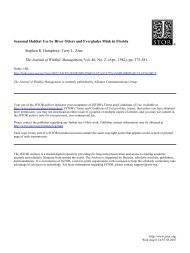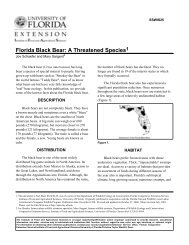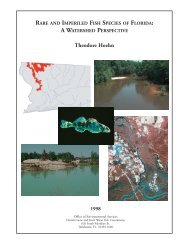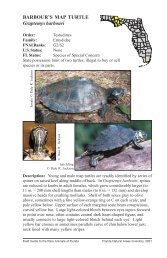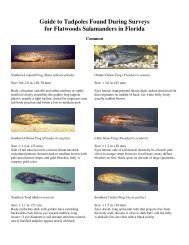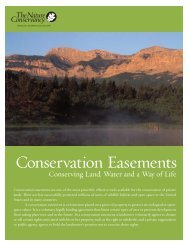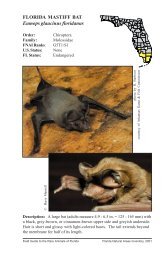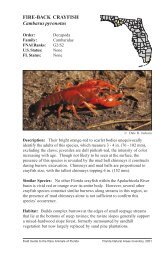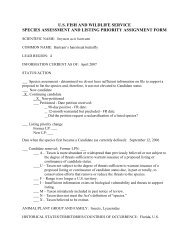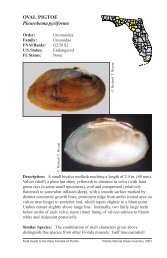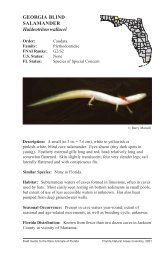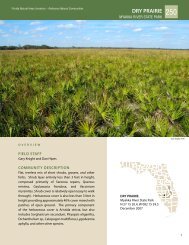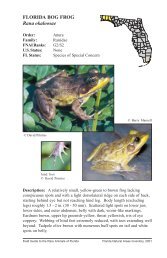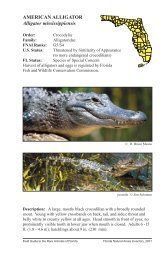population density of the endangered florida key deer - BioOne
population density of the endangered florida key deer - BioOne
population density of the endangered florida key deer - BioOne
You also want an ePaper? Increase the reach of your titles
YUMPU automatically turns print PDFs into web optimized ePapers that Google loves.
572 DENSITY OF KEY DEER • Lopez et al.J. Wildl. Manage. 68(3):2004prior to necropsy or necropsied immediately. Carcassquality or ability to determine cause <strong>of</strong> deathranged from good to marginal (Nettles 1981,Nettles et al. 2002). Age, sex, body weight, andcause <strong>of</strong> death were recorded for each animalusing procedures described by Nettles (1981).Data AnalysisWe estimated <strong>density</strong> for Big Pine and NoName <strong>key</strong>s from SIU and TAMU survey datausing Lincoln-Petersen (Seber’s modification)and Schnabel estimators (White et al. 1982, Krebs1999). These survey routes met <strong>the</strong> requirementsfor both estimators because each survey adequatelycovered what was considered a closed<strong>population</strong> (both areas are islands, with limiteddispersal between islands and small <strong>population</strong>growth), and a segment <strong>of</strong> <strong>the</strong> <strong>population</strong> wasradiomarked when surveys were conducted.We compared <strong>population</strong> estimates betweenislands and time <strong>of</strong> day (sunrise, sunset) usingrepeated-measures analysis <strong>of</strong> variance (ANOVA;Tzilkowski and Storm 1993, SPSS 2001, von Ende2001). Repeated-measures ANOVA accounts forlack <strong>of</strong> independence when repeated observationsare obtained from <strong>the</strong> same experimentalunits (Zar 1996). We log transformed <strong>density</strong> estimatesand selected random samples within yearsto obtain a balanced design. Critical assumptions,such as normality and circularity within <strong>the</strong> variance–covariancematrix, were assessed prior tohypo<strong>the</strong>sis testing. We tested for equality <strong>of</strong> errorvariances using Levene’s test, and we examinedtrends among years (within-subject factor) usingpolynomial transformations (orthagonal contrast;von Ende 2001). Following Lomax (2001),we reported conservative Greenhouse-Geisserprobabilities along with <strong>the</strong> standard F-statistic(Greenhouse and Geisser 1959). Last, we calculatedan overall Schnabel estimate (Krebs 1999)between islands and study (historical, current),and we compared <strong>the</strong>se estimates to averagedLincoln-Petersen estimates.To evaluate Key <strong>deer</strong> <strong>population</strong> trends fromUSFWS survey and mortality data (1976–2000),we compared <strong>the</strong> average number <strong>of</strong> <strong>deer</strong> seenannually to annual <strong>deer</strong> mortality using a Spearman’srank correlation coefficient (Ott 1993). Wecalculated <strong>the</strong> annual finite rate <strong>of</strong> increase (R;Caughley 1977) for successive years for USFWSsurvey and mortality data, and we compared <strong>the</strong>average <strong>of</strong> <strong>the</strong>se estimates to estimates <strong>of</strong> R fromSIU and TAMU survey data using a Student’st-test (Ott 1993, Minitab 1998).RESULTSTrapping and MarkingDuring December 1968–June 1972 and January1998–December 2001, we captured and marked434 Key <strong>deer</strong> (historical = 179, current = 255;fawn female = 41, yearling female = 43, adultfemale = 147, fawn male = 66, yearling male = 54,adult male = 83). The average number <strong>of</strong> markedanimals available on a weekly basis by island andstudy was 76 (range = 62–90) for Big Pine historical,48 (range = 34–64) for Big Pine current, and22 (range = 18–35) for No Name current.Approximately 67–75% <strong>of</strong> animals captured wereradiomarked during both studies (SIU =120/179, TAMU = 191/255).Density EstimatesWe conducted 889 roadside surveys (USFWS =266, SIU = 54, TAMU = 569; Table 1). From historicalweekly surveys (1971), we estimated 167 (95%CI: 149 to 185) and 34 (95% CI could not be calculated;Silvy 1975) Key <strong>deer</strong> on Big Pine and NoName <strong>key</strong>s, respectively (Table 1). From currentweekly surveys (1998–2001), we estimated 406(95% CI: 378 to 433) and 76 (95% CI: 72 to 80) Key<strong>deer</strong> on Big Pine and No Name <strong>key</strong>s, respectively(Table 1). Conversely, Schnabel estimates indicated170 (95% CI: 154 to 191) Key <strong>deer</strong> on Big PineKey from historical surveys, and 390 (95% CI: 371to 411) and 79 (95% CI: 75 to 84) Key <strong>deer</strong> on BigPine and No Name <strong>key</strong>s, respectively, from currentsurveys (Table 1). Schnabel and weekly Lincoln-Petersen <strong>population</strong> estimates were similar (P >0.05; Table 1). Density estimates indicated <strong>the</strong>Key <strong>deer</strong> <strong>population</strong> on <strong>the</strong>se 2 islands increasedby 240% (482/201) between 1971 and 2001.The repeated-measures ANOVA was conductedusing a balanced design that maximized <strong>the</strong>number <strong>of</strong> surveys within each island × year × surveyperiod combination. One data point (BPKsunset; estimate = 6.5 <strong>deer</strong>) was considered anoutlier and removed from consideration. Becauseno o<strong>the</strong>r data were available, <strong>the</strong> 1971 <strong>population</strong>estimate <strong>of</strong> 34 (Silvy 1975) was used for No NameKey and resulted in a loss <strong>of</strong> homogeneity for thatyear (Levene’s test; P = 0.004). All o<strong>the</strong>r yearsdemonstrated equality <strong>of</strong> error variances by Levene’stest (P >0.132 for all remaining years). Therepeated-measures ANOVA results indicated noyear × survey (P = 0.743), year × island (P =0.294), or year × survey × island (P = 0.304) interactions;<strong>the</strong>refore, <strong>population</strong> estimates amongyears were not influenced by ei<strong>the</strong>r time <strong>of</strong> survey



